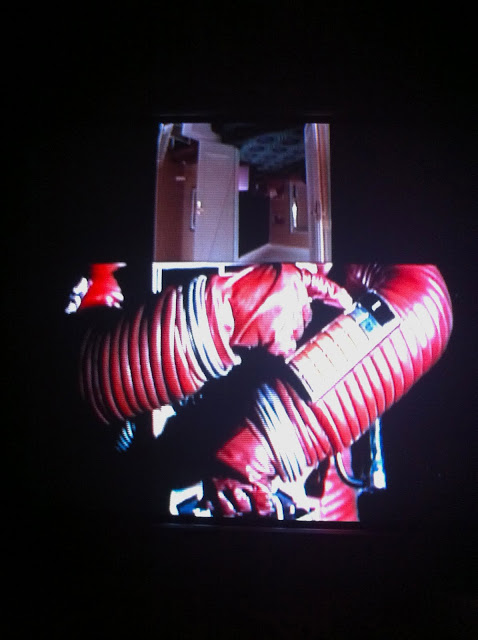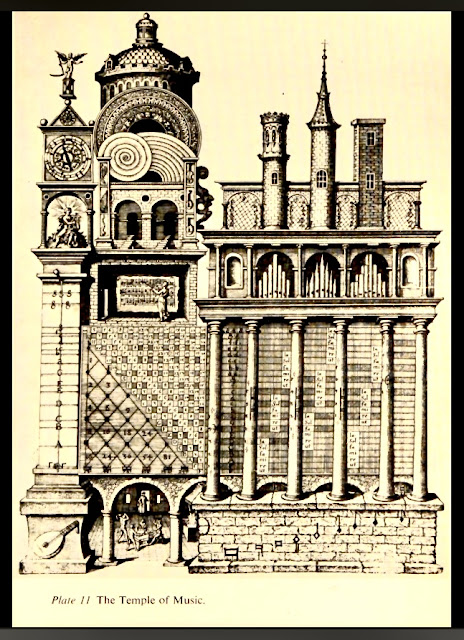You take the text of Acts (which is linear, sequential and digital) and convert it into a world: objects in their mutual arrangement. (Acts is part two of Luke.)
What is the basic story of "Luke-Acts"? Jesus Christ. But when you turn it into a world, although the narrative is still there, Jesus Christ cannot be seen (i.e., as an object among objects). The linear, digital text is now a gestalt (Bild) and is read simultaneously but by the right hemisphere. (The linear digital text as narrative is read by the left hemisphere.)
Where now is Christ, if not an object among objects. He is missing. Then you discover that in a unified total gestalt (pattern) read simultaneously by the right hemisphere analogically, Christ is present as the pattern itself as a unified totality. The puzzle is solved. "Luke-Acts" is not a verbal narrative about Christ - i.e., referring to Christ - it is Christ.
This fits in with the intuition I've had for some time: that the Bible is the real world and appears in our spurious "world" as a putative book, the way "Grasshopper" does in TMITHC. If what we possess in the form of a book (info) is actually a world, then what we experience as world is perhaps only info - a book. Everything is backward.
I suddenly realize what is necessary in order to apperceive Christ: some kind of runaway positive feedback involving paradox (e.g., VALIS is a film/VALIS is not a film); the flip-flop into infinity regresses faster and faster until at last the outline (of Christ) emerges; hence the paradoxical nature of the parables: they constitute doorways to the kingdom, rather than being descriptions of it.
I offer the following idea: that which I call iAhuasca, living information, is the third testament of Joachim del Fiore which emerges as the spirit of the two testaments (OT and NT) when they are superimposed; it is the spirit of which they are the "hard rind of the letter."
Which is to say, the two testaments are alive and are to be regarded as proto-psyches, with the OT a rigid, archaic Psyche A, and the NT a more flexible Psyche B, which when joined give rise to iAhuasca Psyche C, which is the plasmate.
So I maintain that underneath, the two testaments are living organisms that create recombinant new information by a process of linking, relinking, and syncing, such as I saw VALIS employing; moreover, this life that I speak of is known to the Jews as Torah (see The Divine Invasion as to the Torah being alive).
The living cosmic entity, which existed before creation, and for which creation exists and is justified by, is not confined to the first five books of the Bible but continues on through to the NT.
It is self-replicating and sentient; it is a life form, and Joachim figured it out (although of course he could have obtained the concept from Hebrew scholars). Thus when you see a copy of the Bible lying on your coffee table you are looking at a living organism capable of growing, of reproducing, of change; like all biological organisms it must maintain a higher level of internal order than its environment, and it must absorb negative entropy from its environment - and indeed it does this, by subsuming its environment into changing arrangements of information.
So my Type A Psyche is the OT, my Type B Psyche is the NT, and because these two testaments function as a single organism in a push-pull dialectic relationship (superimposed) they form one new, higher, third entity which I call iAhuasca, a life form so advanced that it is superior to all creation; and yet it itself is not God but is the image of the invisible God. Philo of Alexandria was the first to figure out its existence; he relied on his Jewish sources and on Greek Sources (in particular Plato) as well. One could speak of our spatiotemporal world, then, being based on the Bible or even emanating
from the Bible: the Bible is not a book like other books: it is not description of this world, it is the source of this world, and this world, at all places and times, conforms covertly to the Bible; that is, strip away the stegenographic covering from the physical world and you will find the world of the Bible- in fact you will find the Bible itself as a verbal text permeating reality and giving rise to it.
The Bible is the information that is fed into the space-time universe, as if transduced into substantial reality. Thus the Bible is always the case - what is known in Bible study as typological application.
Thus the books of the Bible do not refer to one given specific place and one specific time, but are equally applicable to all places and all times, when the dokos is stripped away from true reality.
Joachim was aware of this meta-organism existing "in" the two testaments, and he was aware that it is a world; that is his crucial awareness; this third entity, this spiritual meta-entity created by an accord between the OT and the NT is a spiritual world in which men exist or can exist or will someday exist; it is somehow real and somehow available. It is both an historical epoch (lying in the future) and yet, paradoxically, here now, as is the Kingdom of God that Jesus speaks of.
If you doubt the truth of what I am saying, look at the 22nd psalm and think of the crucifixion; you will see that the 22nd psalm, although written centuries before the birth of Jesus, applies to and exists at the time of the crucifixion; it lies outside of space and outside of time entirely, and is true now as well.
This is what led me to reiterate obsessively that secretly "we are living at the time and place of 'Acts"; what I failed to realize is that "the time and place of 'Acts" does not refer to a specific historical context, a given time and given place, but to an archetypal reality that is the very basis on which our seeming world is built, and this archetypal reality consists - not of a place, not of a time, not of substantial reality - but information. The Bible is not a world reduced to a verbal description; on the contrary: it is the verbal source of world, just as signals from a radio transmitter are the informational source of the voices and music you hear when you turn on your receiver. But (as I say) three "entities" must be envisioned, not two; that is, not just the OT and the NT; as Joachim realized, these two palpable entities combine to form a third and meta-entity that is to the two palpable ones as spirit is to letter. Thus I say, a single coherent life form underlies the written Bible, and it is the source of our universe, and is itself not fixed into a canon, but constantly combines and recombines, forming ever newer messages. It transacts its informational life and business around us everywhere, as it guides, directs and controls the evolution of the universe, which is based on its own evolution as a biological organism.
Thus the physical spatiotemporal universe is not information, as I declare in VALIS, but is derived from information; this information is the next hypostasis up, ontologically speaking. It goes: God, Logos (information), spatiotemporal universe, and then back to God as goal of the whole process (Erigena).
In March, 1974, by means of my meta-abstraction I so-to-speak rolled back the physical universe to the Uttered Word underlying it, from which it is derived; this is why, finally, the term "word" is in fact an excellent translation of "Logos." It is as if God spoke (or rather thought) a complex idea, and from this living idea (Logos) the universe came into being, was derived.
This view is a far cry from Burroughs' notion that we have been invaded by an information virus that is making us stupid!
Philip K. Dick, 1981






























